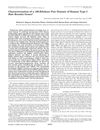TLDR Monilethrix severity varies and may be influenced by other genetic or environmental factors.
Monilethrix, a rare autosomal dominant hair disorder, was studied in 12 families and sporadic cases, focusing on mutations in the helix termination motif of keratin hHb6. Mutations were found in 6 families, with 4 families exhibiting known mutations (Glu413Lys and Glu413Asp) and 2 families showing a novel mutation (Glu402Lys). The study found no clear link between mutation type and disease severity, as heterozygous family members displayed varying symptoms, while homozygous individuals in a consanguineous family were more severely affected. This suggested that other genetic or environmental factors might influence the condition.
34 citations
,
November 1998 in “Journal of Investigative Dermatology”  74 citations
,
October 1998 in “Journal of biological chemistry/The Journal of biological chemistry”
74 citations
,
October 1998 in “Journal of biological chemistry/The Journal of biological chemistry” The 190-kbp domain contains all human type I hair keratin genes, showing their organization and evolution.
26 citations
,
October 1998 in “Experimental Dermatology” A keratin hHb6 mutation causes a hair disorder with varying severity, influenced by other factors.
47 citations
,
July 1998 in “Journal of Investigative Dermatology”  32 citations
,
February 1998 in “The journal of investigative dermatology/Journal of investigative dermatology”
32 citations
,
February 1998 in “The journal of investigative dermatology/Journal of investigative dermatology” Two specific hair keratin genes are active during hair growth and decline as hair transitions to rest.
100 citations
,
November 1997 in “Human Genetics” 21 citations
,
September 1997 in “British Journal of Dermatology” Monilethrix is linked to the type II keratin gene on chromosome 12q13.
175 citations
,
August 1997 in “Nature Genetics” 61 citations
,
February 1997 in “Differentiation” 43 citations
,
April 1996 in “Journal of Investigative Dermatology” 52 citations
,
October 1995 in “Experimental Cell Research” 54 citations
,
January 1995 in “Human Molecular Genetics” Monilethrix is linked to a gene cluster on chromosome 12.

